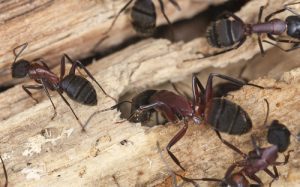Carpenter Ants In Winter
By Chris Williams on February 15, 2011.
Q. It’s February and I have big black ants in my kitchen. Why would ants be active now!
A. Great Question! We are just starting to see carpenter ants come out of hibernation. Any large black ant in New England is a carpenter ant. These robust ants live in hollow trees, stumps, and logs. Within homes, wall voids, siding, insulation, hollow doors, and stored items may provide similar nesting locations sought out by queen ants. Carpenter ant nests outside hibernate in tight groupings within these hollows or in the soil below stumps in Winter. As the temperature drops, levels of glycol build up within the ants cells, allowing them to lay dormant without freezing. The colony will sleep until the warm days of spring. A long, cold winter will allow the colony to sleep without interruption. Warm winters or mild periods may trigger a colony to become active. Nests located within structures may receive an early wake up call as southern sides of the house heat up. Nests located within warm interior walls may never fully settle down, these colonies are usually the first to show up. With snow on the ground, we know the ants are not coming in from outside. Once a colony comes out of hibernation the ants are still clustered together, with the queen in the center. Some ants begin to search for water and are often the first ants seen, slowly heading towards the kitchen or bathroom. Sinks, dishwashers, bathtubs, and toilets are all sources of water molecules. Ants can find water sources and make a trail back to the nest. Sometimes it leads right to the nest, making finding the nest much easier. Other times the trail disappears to unknown locations.

Carpenter ants get most of their moisture from the insects that they eat, but since the nest is awake in winter, they cannot feed. House plants with pests, pet food, grease, and sugary food sources may be of interest to carpenter ants this time of year. Once leaves form on tress and shrubs outside, the ants will head outside, and may be less noticeable. The nest still lives in the house and is foraging for food outside. Carpenter ants walking all over the driveway, front steps, decks, in summer may indicate these foraging activities. Carpenter ants do not eat wood, but get their name from their ability to chew through wood and other materials to enlarge or create nesting areas. Inside the nest, the queen lays eggs that form little white larvae, who are the stomach of the colony. Adult workers of several sizes bring food back to the larvae who secrete a nutritious fluid back. The larvae later pupate to become either workers, female reproductives, or wasp-like males. Mature colonies may be very large and spread out to several locations. Colonies mature in 1-2 years, producing large black flying queen ants and wasp like males. If swarming occurs within a home, the nest is located somewhere inside. In late June, millions of male and female carpenter ants are released from nests located outside and can be seen bumbling around looking for a nesting site. Much can be done to prevent and combat carpenter ants. Treatment of carpenter ants can be done any time of the year. Licensed Pest Control Professionals from Colonial Pest Control can make safe and effective treatments that will kill the carpenter ant colony. Depending on each individual site, treatment may include; low impact baits, non-repellent targeted treatments, and direct treatment of the nest itself. At Colonial Pest Control we have built our reputation on carpenter ant control. We offer one time ant treatments with an exceptional warranty, preventative treatments, and much more. Give us a call today!